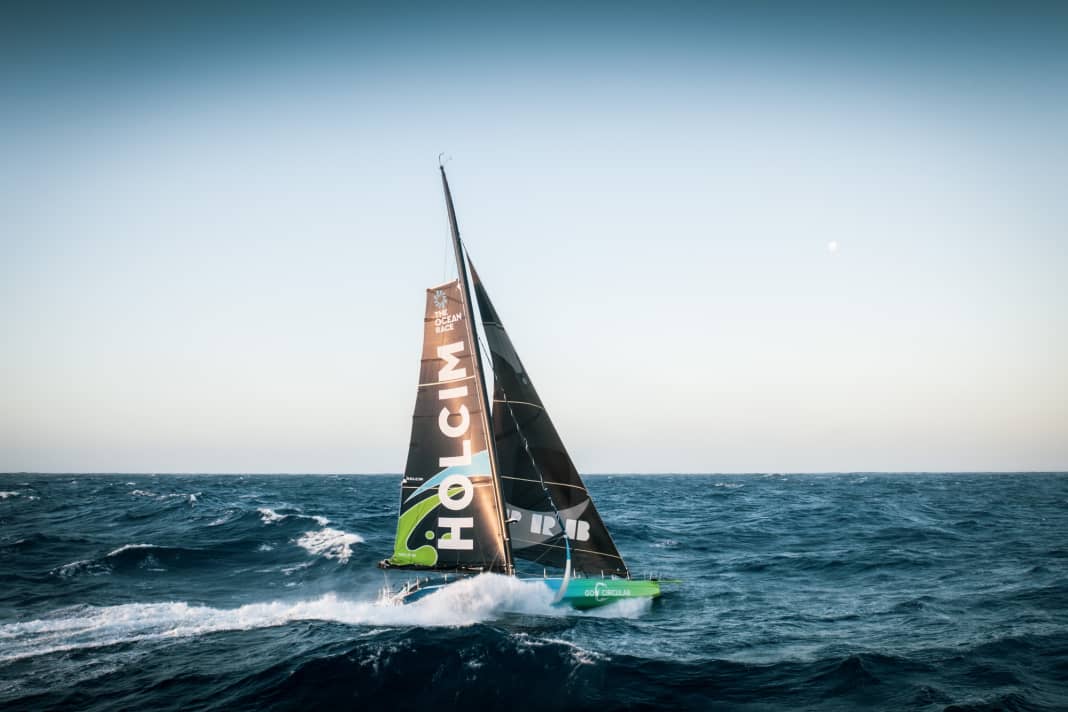





The sailing wardrobe of the Imocas is one of the main factors that determine the success of the Imoca teams in The Ocean Race Europe and yet tends to go unnoticed. Above all, the wear and tear that already sets in during the first stages could have consequences that lie far into the future. This is because the sailors only have a very limited number of cloths at their disposal. Thomas Jullien, surveyor for the Imoca class, explains the limits: "According to the class rules, they are allowed to sail with a maximum of eight sails on board, one of which must be the storm jib, which is mandatory. There is also a special rule for The Ocean Race, which states that each team may use a total of eleven sails plus the storm jib during the entire circumnavigation."
To a certain extent, four sails are essential basic equipment for every boat when it is on course: the main, the J2 working jib, the J3 heavy weather jib and the J4 storm jib.
That leaves four sails that can be set for rougher courses or light winds: This is the segment in which the sail plans differ the most, and the exact dimensions and specifications are guarded like state secrets.

In fact, well-funded teams develop a much broader portfolio of sails in order to gradually find the best setup. However, they are strictly limited in use. Using the example of "Malizia - Seaexplorer", here is a selection of the cloths used on the third leg, which we also show individually in the gallery above.
Only the A2 spinnaker, the largest Imoca sail, is not on board on this leg: it is suitable for deep courses in light winds and will be important on the fourth leg from Itajaí to Newport, where the aim is to overcome the squalls. Either the jib zero or the fractional zero, or "FR0" for short, will be missing.
Mainsail - the main engine with four-speed gearbox
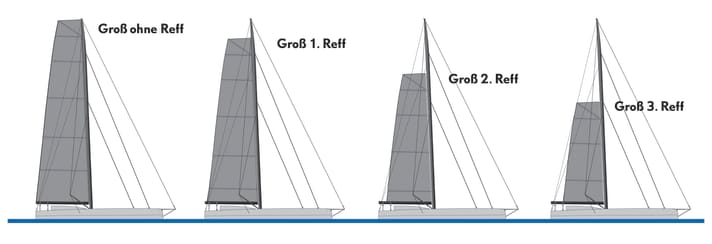
If possible, the large must last for the entire distance of The Ocean Race. This is because it is very expensive and cannot be "doubled". No Imoca team has a replacement on board, because changing it would be difficult at the very least and virtually impossible in solo mode. If it tears completely horizontally, as happened to the Japanese Kojiro Shiraishi on his "DMG Global One" in the Atlantic during the last Vendée Globe, the only option is to abandon the boat or spend days repairing it.
For this reason, Boris Herrmann specifically ordered a particularly stable specification for his main from North Sails and even accepted up to ten per cent extra weight for it. This shows how crucial this sail is for success - and how critical even minor damage can be.
When the leech line broke on "Holcim - PRB" at the beginning of the second week of leg three, Kevin Escoffier did not hesitate to have it repaired because he thought the risk of a flapping leech in the windy Indian Ocean was too great. He had the sail recovered and pulled in a new line with Sam Goodchild and Tom Laperche standing on the cockpit roof, which cost the leaders a good 20 nautical miles, but avoided damage to the main.
A lot has changed in mainsail design in recent years. Because the foils, and with them the speed potential, have become ever greater, the surface area in the top has become significantly smaller. In contrast to earlier cloths measuring around 180 square metres, the current Imocas only have around 170 square metres in the main, which not only reduces drag, but also pushes the reefing limit upwards. This in turn helps to reduce unwanted turbulence behind the free-standing masthead when reefed.
While older boats in this class had up to four reefs, today three are sufficient. This means that there are four performance levels for the main: unreefed, reef 1, 2 and 3, each of which can be combined with different headsail configurations. In stormy weather, the crews take the main down completely in case of doubt and only sail with the J4 - but only in winds of 50 knots or more.
J0 - the latest addition to the Imoca class
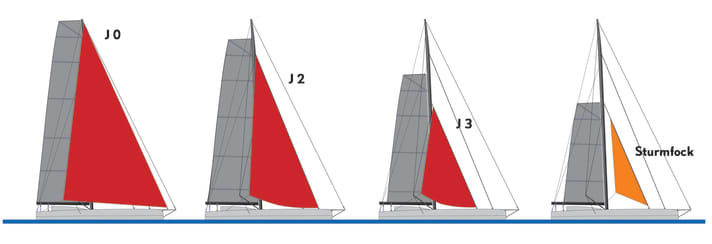
If you like, the J0 (pronounced: tschej si:ro) used on the Topp halyard is a kind of Genoa 1 of modern times. The membrane sail, which is around 135 square metres in size and has a relatively flat cut, is used in light winds; however, it can also provide propulsion on rougher courses in winds of more than 20 knots - for example, if the code zero is too large or if the top halyard is broken.
Some Imocas moor the J0 at the bow; however, more and more teams are dispensing with their own jib, such as "Charal 2", which is why the J Zero is then sailed on the aft furler on the bowsprit.
J2 - the Swiss Army Knife under the headsails
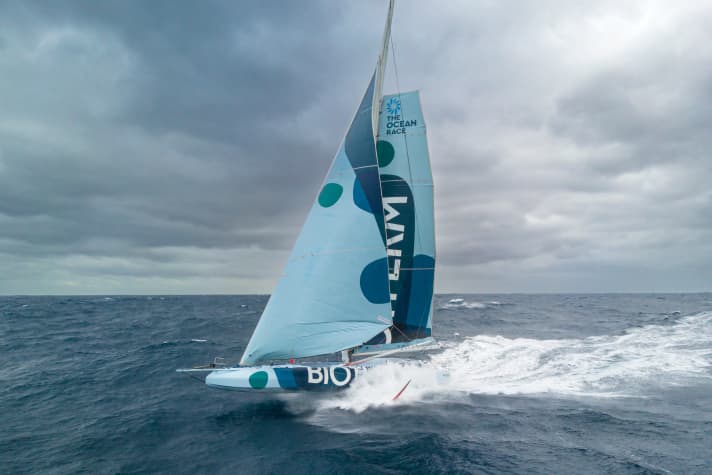
Almost as indispensable as the main is the J2, which can be called a working jib with a clear conscience. It is used on a structural forestay, so called because it holds the mast and cannot be removed - unlike all other stays in the bow area.
Strictly speaking, the J2 is actually a G2. This is because the "J" stands for "jib" and refers to a jib. However, the J2 is a headsail that overlaps the mast and is therefore, unlike the J3 and J4, a genoa. However, for the sake of simplicity, riggers and sailmakers stick to the same nomenclature, which is why we do the same.
The J2 works in a variety of configurations and on different courses. Downwind, it is the sail of choice up to around 18 knots true wind speed; however, it can also be used very efficiently on half-wind and room-sheet courses in 25 to 30 knots of wind, especially as the new foilers require less surface area and pressure than more conventional Imocas anyway. The J2 measures around 95 to 100 square metres and is now cut as low as possible to the deck to prevent pressure equalisation between the windward and leeward sides. The lower leech only rises towards the leech because otherwise it would come into contact with the outriggers of the wing mast.
However, it does have one disadvantage, and this has already been demonstrated on three ships in the Southern Ocean: "11th Hour Racing", "Holcim - PRB" and "Malizia - Seaexplorer". If it tears or punctures, it can't just be rolled up and knocked off like the J3, which is also possible in strong winds. Repairs are therefore usually carried out with the sail upright. However, the sail must be dry and as salt-free as possible, which explains why "11th Hour" had to wait days for the right weather window to apply a patch - and why it stopped much further south than its competitors.
J3 - the not-so-little sister of the J 2
If the J2 is too big or broken, the crews at The Ocean Race quickly switch to the heavy weather jib. This is used on a removable stay to make tacking or gybing with the J2 easier. It only measures around half the area of its big sister, i.e. around 50 square metres. Because it is cut even flatter than the J2 and produces less drag, the most efficient foilers sail with the J3 from 20 knots in windswept upwind or reaching courses.
Even in light and medium winds, however, it still plays an important role on such courses: it helps to bridge the gap between the spinnaker or code. As a so-called double header, the configuration has become indispensable in the Imoca class, especially in The Ocean Race, because unlike in solo regattas, more hands are available here to get the last out of the boats in full regalia.
J4 - the compulsory sail that no skipper actually wants to set
The storm jib is a robust, comparatively tiny triangle of canvas that is designed to take the worst knocks in extreme wind conditions. It can happen that boats sail with only the storm jib in apocalyptic conditions that they would rather not experience, but which can certainly occur in the Southern Ocean, for example.
In The Ocean Race, the J4 served as a replacement jib for one day on board "11th Hour Racing" because both J2 and J3 had holes in the railing supports near the lower leech. The storm jib was also used on several boats at the stormy start of the race in the Strait of Gibraltar.
When it is often said that only eleven sails are allowed for the entire duration of The Ocean Race, then the J4 falls by the wayside. You can do it that way, but it is misleading. Just because the sail is mandatory doesn't mean you should leave it out.
A2 - the "Big Blooper" of the Imocas
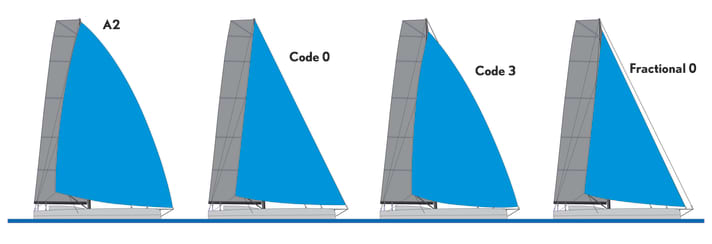
The only space windsail that is not used on a furler is the "Topp-Spi" or "Spi Max", more correctly referred to as A2. "A" stands for asymmetrical, the 2 for a particularly bulbous cut optimised for deep courses with relatively broad shoulders. It can measure up to 400 square metres and is relatively unpopular with solo skippers on the Vendée because it can only be jibed or recovered with risk in fast freshening winds. To make it manageable at all, it is sailed in a recovery tube.
On leg two from Cape Verde to Cape Town in The Ocean Race, he proved to be a game changer because the north-east trade winds were disturbed and the squalls were relatively wide. Even at the start, the boats that had him on board had visible advantages. Only Kevin Escoffier ("Holcim - PRB") and Boris Herrmann ("Malizia - Seaexplorer") decided not to take him on board. In retrospect, this proved to be a mistake, as neither the A3 nor the Code Zero were an adequate substitute for VMG courses in light winds.
Code Zero - the flat giant
For many owners of cruising yachts, the Code Zero has become a favourite additional sail - often the only one apart from the main and genoa. This is because it is easy to furl and can be used both for upwind courses in light winds as well as for rough courses in strong winds.
This applies to the Imocas in a similar way, although the Code Zero is more of a specialist than an all-rounder. It is used on the top halyard, has a surface area of around 300 square metres and is made of a high-strength membrane, which makes it very heavy - a good 80 kilos. When rolled up, sailors sometimes call it the "Anaconda" because they have to heave it on deck when recovering, as if it had a life of its own. And it does when the wind and swell cause it to sway.
Code 3 - the heavy weather spy
Smaller and flatter than the A2, but rounder than the Code Zero - that's the Code 3, which used to be called the A3. But it has in fact become flatter in the meantime due to the increasingly forward apparent wind that the current foilers produce at full speed and therefore justifies the change from "A" to "C".
Measures between 220 and 250 square metres, is ridden on a fractional halyard and can be furled away for recovery, making it much more manoeuvrable than the A2. The sail of choice in the Southern Ocean when a crew manages to get in front of a low and achieve maximum speed on room sheet courses in moderate seas and medium winds.
FR0 - the little brother of code 0
Counts in the strong wind wardrobe, which is why it is almost a must-have sail in the Southern Ocean. Not too far removed from a J0, which is smaller, and the C0, which is significantly larger. The reaching sail for medium winds - and more than that.
As a fractional zero, the FRO (pronounced "Frouw") is set on the fractional halyard and always travelled on a furling system on the bowsprit. If the A3 leaves the mooring lines or goes overboard, it can take over its function on room sheet courses in strong winds.
The details of each sail inventory remain secret
So much for the most important and most common sails of an Imoca today. You have to think of it like a multiple gear shift, because the main with its three reefs and the partly complementary headsails can be combined into around 20 sensible sail plans. In fact, working out the best setup is an enormously important lever in optimising the boats for the Vendée Globe 2024. Added to this are the variation options for the foils, which can be adjusted in terms of angle of attack and degree of reach.
The enormous performance boost of Paul Meilhat's "Biotherm" shows what potential there is to be discovered. She was never the fastest boat in the South Atlantic on leg two, which probably had something to do with a structural weakness that had to be rectified in Cape Town. On leg three, however, the French consistently logged the highest times when it came to closing the gap on Kevin Escoffier.
Thomas Jullien, measurer of the Imoca class, describes the competition for the best sails as follows: "Occasionally, someone comes up with a ground-breaking design, a 'wonder weapon' that no one else has thought of." Even if he had seen such a sail, as an official he would be bound to discretion. The details of each sail inventory remain confidential for each team. "It could be that someone asks me to stamp a crazy sail and it will be interesting to see if the sails get more and more special," he speculates.
"But it's not magic. The more you specialise in a sail for a certain condition, the less good it is in other conditions. I don't think anyone has yet invented a magic sail that is perfect in all conditions. So it really depends on what conditions the teams are expecting and how much they want to tailor their sails to them. Or how broadly they define the purpose in terms of wind speeds and angles so that they don't have to change as often when the conditions change."
One thing is clear in any case: any damage to an important sail such as the main or J2 limits the options for the rest of the race. And that can really make the difference between finishing and winning. The J2 is on the change list of many teams in Itajaí. Based on the existing sails, this means that ten of the twelve permitted cloths have already been used up.
Because Team Malizia had to cut Code Zero completely free at the start of the third stage, Boris Herrmann will also replace it. That makes number eleven out of twelve. This means that only exactly one sail can be measured as a replacement for the remaining stages to Genoa, which account for 60 per cent of the possible points.
And the Southern Ocean is still long!

